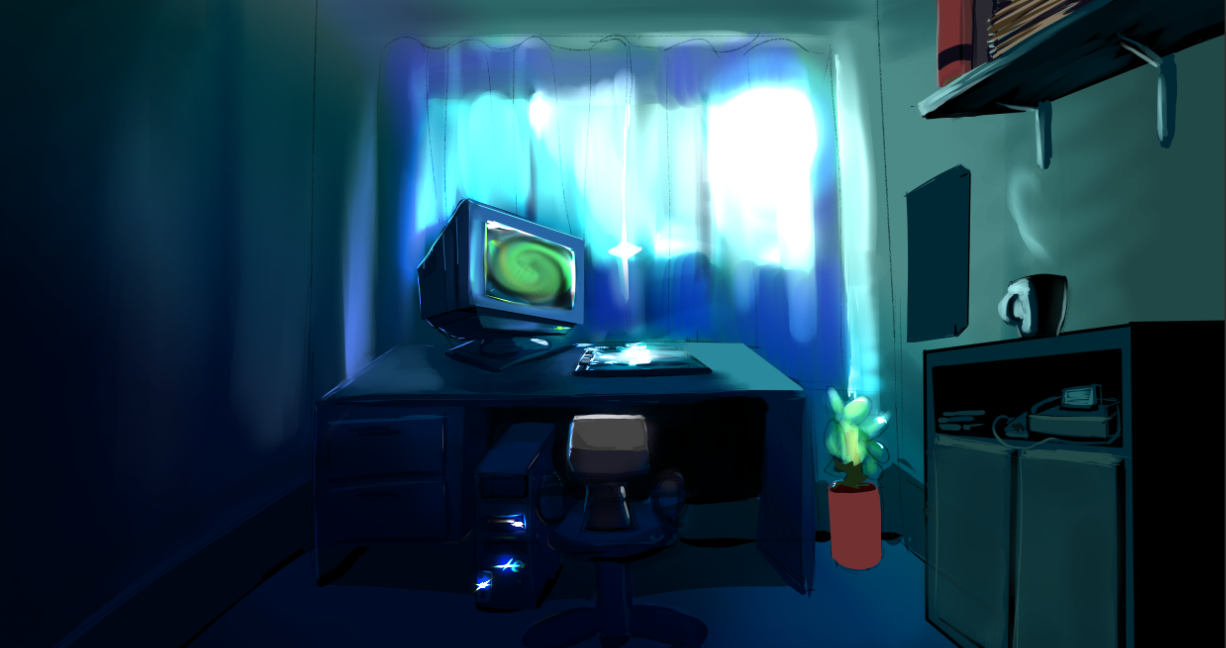This blog was partially typed on an ancient 70s/80s era keyboard.
On IRC a while back, I mentioned that I had an old PC/AT clone sitting in my garage, along with a monitor, keyboard and good ol' dysfunctional CGA board :POriginally, the plan was to 'restore' it, and mess around with it's ancient processor; but eventually that idea faded. I can't find a compatible CGA board anywhere (That I don't have to pay through my nose for).So anyway, I took a crappy PS/2 keyboard, cut it's wires, and connected it's connector to the ancient keyboard. Here's some photographs: And here you have my computer station, and a glimpse of my current living quarters. The keyboard is in front of the monitor.
And here you have my computer station, and a glimpse of my current living quarters. The keyboard is in front of the monitor. Here's a closeup shot of the keyboard, in all it's faded yellow glory :PNote the lack of a Windows key (It has a MACRO key instead :3)
Here's a closeup shot of the keyboard, in all it's faded yellow glory :PNote the lack of a Windows key (It has a MACRO key instead :3) And here we have my workspace (I need a workbench, seriously), along with the gutted remains of a pitiful excuse for a keyboard. Also, there was a lot of dirt inside the old keyboard. I'm still dealing with it (Some contacts need cleaning. The a, d, Up Arrow, Right Arrow, l, ', Tab and End keys aren't responding). Oh. And have a picture I took of my guitar and a fragment of my game collection, since I was trigger happy with the camera:
And here we have my workspace (I need a workbench, seriously), along with the gutted remains of a pitiful excuse for a keyboard. Also, there was a lot of dirt inside the old keyboard. I'm still dealing with it (Some contacts need cleaning. The a, d, Up Arrow, Right Arrow, l, ', Tab and End keys aren't responding). Oh. And have a picture I took of my guitar and a fragment of my game collection, since I was trigger happy with the camera: Yeah. My room's crowded and therefore quite a mess. Though I usually keep it clear enough; tripping over electronic bits and pieces at midnight isn't fun.Anyway…The technical processRight. I had read some articles online about converting the DIN connector to a MicroDIN (PS/2) connector, and information was vague, and basically sums up to "It varies per keyboard, figure it out". So I opened up both, cut the cables, and examined the PCBs. Most four-pin/five-pin keyboard connectors follow a similar pattern: V, GND, DATA and CLK. This was labeled on the newer (PS/2) keyboard, but not on the AT keyboard. My initial attempt (Which turned out to be correct, too), had me wiring them in 'logical order', based on the connectors on the board.Now, my only concern is with cleaning the mechanical switches. A lot of dirt and some corrosion has set in. Fortunately, it's nothing that can't be fixed.Oh, and typing on this thing is loud, and awesome :D
Yeah. My room's crowded and therefore quite a mess. Though I usually keep it clear enough; tripping over electronic bits and pieces at midnight isn't fun.Anyway…The technical processRight. I had read some articles online about converting the DIN connector to a MicroDIN (PS/2) connector, and information was vague, and basically sums up to "It varies per keyboard, figure it out". So I opened up both, cut the cables, and examined the PCBs. Most four-pin/five-pin keyboard connectors follow a similar pattern: V, GND, DATA and CLK. This was labeled on the newer (PS/2) keyboard, but not on the AT keyboard. My initial attempt (Which turned out to be correct, too), had me wiring them in 'logical order', based on the connectors on the board.Now, my only concern is with cleaning the mechanical switches. A lot of dirt and some corrosion has set in. Fortunately, it's nothing that can't be fixed.Oh, and typing on this thing is loud, and awesome :D
That's really awesome, I intend to get a mechanical keyboard too, though it'll probably be a more recent model. Saying that, retro keyboards like yours are rather popular now, and may be worth an enjoyable amount.
Thanks. The faulty keys turned out to be a faulty resistor (This things got about 20 of them). I'm going to have to go hunting around for a replacement sometime soon.
Interesting thing: This has a legit Intel 8748 Clock Chip on board, along with two Toshiba chips for the 'encoding' of the key codes and such.I got a mechanical keyboard modeled after the model M keyboard. I love that thing.
That keyboard looks so much like the first one I remember using with a Windows 95 machine long, long ago that I had to stare at it for ten minutes to convince myself it wasn't the same model. D:
Thass pretty cool though. Also that looks like a copy of "Bury My Heart at Wounded Knee" on the shelf there. And a bookmark that says "Don't bug me while I'm reading" with a drawing of an insect on it. I think I like your bookshelf.Hobbyists are what make the computer industry so awesome, honestly :P
that keyboard looks… hideous.
And don;t get me started on crowded rooms, my room… is a f***ing disaster. Probably because I have to share it with one of them female types. (there's hardly anywhere to actually walk in here.) I've got 2 PC's 2 large HD monitors, a 540 watt Stereo system, 2 Desks and every successful gaming console ever released.See? it's much more entertaining this way. Now i can use my imagination!

Tactical censoring makes things more amusing :P